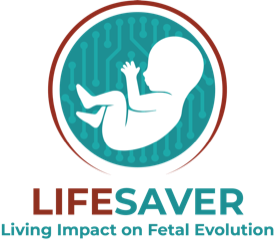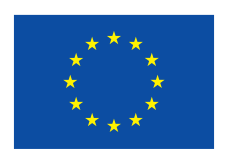LIFESAVER
Living Impact on Fetal Evolution: Shelter - Analyze - Validate - Empower Regulations


Biomedical
In Europe about 75% of all neonatal deaths and 60% of all infant deaths occur in infants born preterm, and worldwide 450 neonatal deaths occur every hour. The number of preterm births is growing despite advances in medicine as more pregnancies are in the later age but also due to increasing environmental treats and lack of suitable treatments.
In the LIFESAVER vision, every pregnant woman must have a proper living environment with the minimal risks to the foetus, safeguarded with scientifically justified regulations in use and control of potentially risky chemical and medicinal products, leading to healthier quality lives of the babies, overarching for generations.
The overall objective of LIFESAVER is to create and demonstrate a novel digitally cloned in vitro system to emulate prenatal conditions near the placental interface. This in vitro system is capable of high biological fidelity and enables the corresponding prediction of the potential risks posed by a drug or chemical to the unborn child. The LIFESAVER concept is based on an original idea to hybridize several innovative technologies and integrate the digital in silico system with the in vitro laboratory system.
Pregnant women can suffer from many conditions that require ongoing or acute treatment and care, not only because of health risks, but also because of environmental pollutants such as chemicals, contaminants, antibacterial substances, and others, which may also affect the unborn child, resulting in premature birth. The LIFESAVER addresses the presently unmet societal and healthcare needs in creating and developing of a validated scientific knowledge base for the development and implementation of regulatory approaches relevant to maternal and fetal health. The outcomes are in design, manufacturing and deployment of a platform having key components of in vitro placental tissue for sufficient emulation of typical prenatal conditions. This aims to provide a solid scientific rationale for new regulations for chemical and pharmaceutical use relevant for the Green Deal vision.
The pioneering LIFESAVER project enables the design, production and implementation of a platform with all the correct key components of placental tissue to enable sufficient emulation of typical/atypical prenatal conditions. The combination of “immortal” perinatal telomerase cells with an in vitro bioprinted, mechanically and fluidically stimulated placental structure has never before been tried to the same extent.
EnginSoft is the coordinator of LIFESAVER and its main technical role is related to the digitalization of the in-vitro system. In fact, EnginSoft will simulate the mechanical and fluid-dynamic behavior of the lab system in order to optimize it and to make it working as closer as possible to real placenta conditions. Further, EnginSoft is responsible of the Design of Experiment that will help to reduce the number of laboratory tests, sorting out only the relevant and effective ones to be performed.
ENGINSOFT | SEQVERA LTD OY | UNIVERSITÀ CATTOLICA DEL SACRO CUORE | ELVESYS | EVERCYTE GMBH | LABORATORIO IBERICO INTERNACIONAL DE NANOTECNOLOGIA | CELLINK AB | PRO-ACTIVE | NATIONAL UNIVERSITY OF IRELAND GALWAY | ISTITUTO NAZIONALE DI RICERCA METROLOGICA - INRIM | THE PLANET CALLS | IDEA STRATEGISCHE ECONOMISCHE CONSULTING | MALTA LIFE SCIENCE CENTRE LIMITED | I3S - INSTITUTO DE INVESTIGACAO E INOVACAO EM SAUDE DA UNIVERSIDADE DO PORTO | FONDAZIONE POLIAMBULANZA ISTITUTO OSPEDALIERO
Funding Scheme Horizon2020 | Call identifier H2020-LC-GD-2020-3, Grant Agreement No 101036702


48 months
November 2021 – October 2025
EnginSoft SpA
Carla Baldasso
15
by Francesco Franchini, Novella Saccenti, Erik Mazzoleni, Daniele Cortesi, Carla Baldasso | EnginSoft
Alessandra Manzin, Riccardo Ferrero | INRIM - Department of Advanced Materials Metrology and Life Science
Futurities - Winter 2024
The LIFESAVER project, funded by the EU, aims to simulate the placenta's function at the end of the first trimester, focusing on the exchange of substances between the mother and foetus. This research is crucial for understanding the effects of pollutants and drugs on the unborn, especially since testing on humans and animals is limited.
The project involves creating a digital twin of the placenta, focusing on the villus structure and surrounding fluid dynamics. Using computational fluid dynamics (CFD) simulations, researchers modelled fluid flow, pressure, and residence times in the intervillous space (IVS), with the goal of predicting how chemicals pass through the placenta. The team developed detailed 3D geometries of the villus and tested various permeability models to find the most efficient setup.
Three geometries were tested, and the results showed that the Carman-Kozeny model in Case 3 was the most efficient, providing better fluid flow, shorter residence times, and consistent pressure distribution, aligning with existing literature. This model promises to enhance the prediction of chemical diffusion across the placenta, supporting safety assessments for pregnant women.
The LIFESAVER project merges advanced bio-digital twins and computational modelling to advance placental research, contributing to the safe screening of industrial chemicals and pharmaceuticals.
by Carla Baldasso | EnginSoft
Futurities - Autumn 2023
LIFESAVER project aims to create and demonstrate a novel digitally cloned in vitro system to emulate prenatal conditions near the placental interface.
Currently ongoing, the project prototype has been recently birthed, having human placenta reproduced in a laboratory.
Read the article
Some of our competences in research and technology transfer

Research project
DigiPrime will create and operate a federated model of digital platforms by developing reliable data sharing mechanisms and preserving the confidentiality of business-critical data, governed by smart contracts and using block-chain tracking.

Research project
Aligned with Europe’s green transition, GeoS-TECHIS supports the EU's "Fit for 55" climate goals by integrating renewable energy, improving efficiency, and fostering the circular economy. Adhering to the European Commission’s "Do No Significant Harm" principle, the project advances environmental sustainability, innovation, and economic growth.